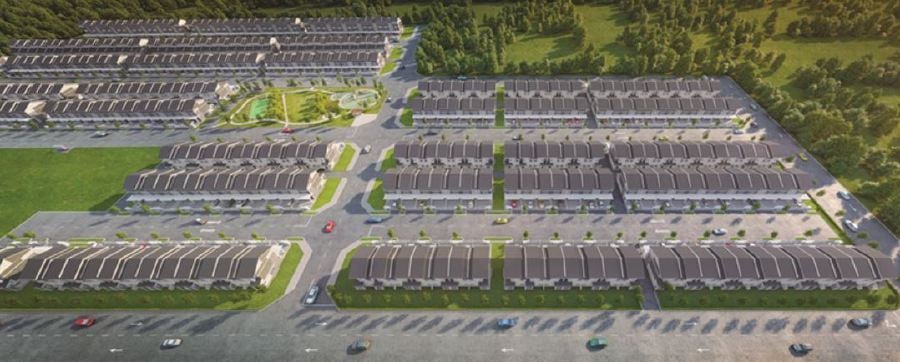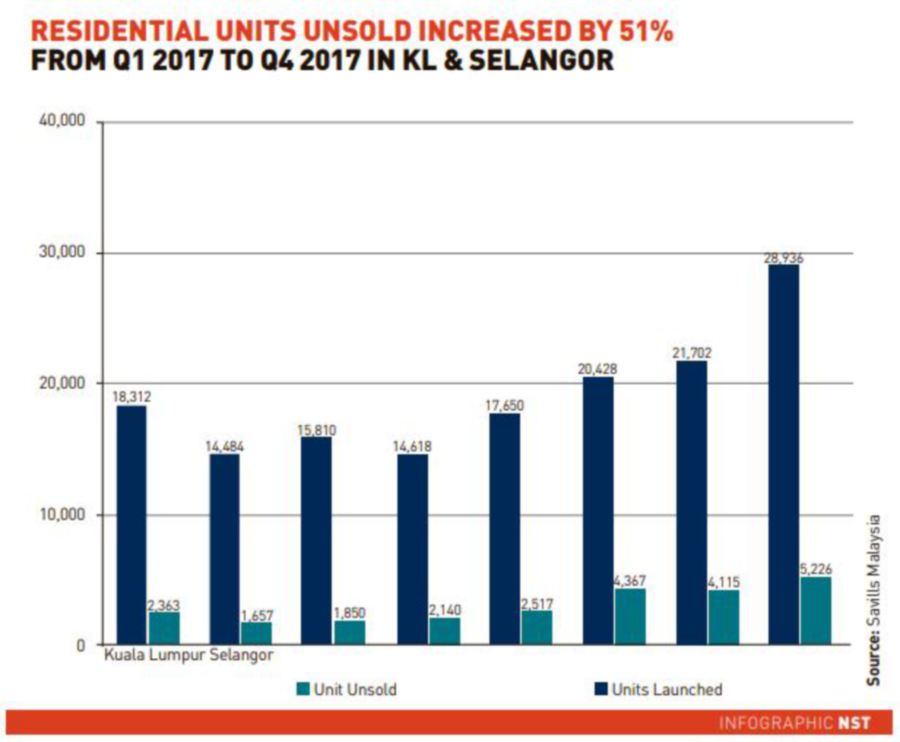LUXURY property sales in the Kuala Lumpur City Centre (KLCC) will remain good, driven by sustained economic growth and increasing demand from local and foreign buyers.
The conclusion of the 14th General Election, coupled with sustainable economic growth, may lead to more people investing in properties as it is viewed as the most viable hedge against inflation.†
But can developers sustain growth if they continue to build luxury properties in KLCC by the hundreds or thousands, and would they be affordable to Malaysians?
Property analysts said even when overall market conditions are negative, traditionally there is more resilience among ultra-wealthy individuals.
“Developers have to identify the city that matters most to the rich and super rich. If they build a tower in KLCC offering more than 200 units of luxury residences, they may be able to sell just about 20 to 30 per cent in the first few months.
“For some developers, they may be able to sell more units as they offer rebates and other incentives to get their family members and employees to also buy,” said an analyst.
The analyst, however, cautioned developers who planned to launch new projects this year in the KLCC area to consider the current market prices that have fallen in the past two to three years.
“If they launch now, it should be at lower prices to attract buyers. Otherwise, they won’t get full support from property buyers and investors as they can buy readily-available units from the market at low prices because of competition. The market has plenty of ready stock.”
Rahim&Co executive chairman Tan Sri Abdul Rahim Abdul Rahman said in February luxury residences in the KLCC area are no longer selling as high as RM2,500 per square foot (psf).
The properties are now selling at below RM1,800 psf, he said in the annual publication of Rahim&Co Research — Property Market Review 2017/2018.
Some luxury residences in the KLCC area have shown negative compound annual growth rate (CAGR) from 2015 to last year.
According to Rahim & Co, the average transaction for high-end condominiums and serviced apartments in the KLCC area, such as One KL, was RM1,093 psf (or CAGR of -9.2 per cent over 2015 to last year).
Quadro Residences had average transaction price of RM1,174psf over the same period (or CAGR at 2.9 per cent).
For The Troika, the average transaction price wasRM1,230psf (or CAGR of -3.7 percent) for 2015 to last year, while St Mary Residences was RM1,237 psf (or CAGR of -5.1 per cent).
Pavilion Residences had an average transaction price of RM1,582 psf (or CAGR of -6.7 per cent ) last year.
Rahim & Co noted that there were some high-end condominiums andserviced apartments in the KLCC area which did well.
The Meritz averaged at RM1,011 psf (CAGR at 2.3 per cent), Park View Serviced Apartments RM1,106 psf (CAGR of 1.8 per cent), Horizon Residences RM1,512 psf (CAGR rate of 5.2 per cent) and Marc Serviced Residences at RM1,536 psf (CAGR rate of 2.6 per cent).
NEW ENTRY IN THE MARKET
Kuala Lumpur’s total supply of high-end condominiums or residences stood at 49,678 units following the completion of 2,298 units in the second half of last year, according to Knight Frank Malaysia’s “Real Estate Highlights for 2nd Half 2017” report.
The units completed in the second half of last year were from projects such as The Mews (1,243 units), The Manhattan (129 units), Tribeca Bukit Bintang (318 units), Dorsett Residences Bukit Bintang (252 units) and The Ritz-Carlton Residences (288 units).
In the first half of this year, a total 1,216 units will be completed, namely The Residences by Tropicana (353units), Four Seasons Place Kuala Lumpur (242 units) and Pavilion Hilltop (621 units).
Although the projects were completed in the second half of last year and early this year, some of the developers still have units to sell.
The Ritz-Carlton Residences by Berjaya Group occupies one of the two 48-storey towers of the Berjaya Central Park development in Kuala Lumpur’s Golden Triangle.
The units range from RM3.34 million to RM9.9 million each.
The units at The Residences by Tropicana are priced fromRM1.78 million to RM9.39 million each.
KSK Land Sdn Bhd may soon launch Tower B, with a total of 468 units, at their 8
Conlay@KLCCproject.
Although there is no firm price tag, it could breach the current record held by Four Seasons Place Kuala Lumpur, sources said.
The residences at Four Seasons Place Kuala Lumpur were sold at record-high prices, including a duplex for an estimated RM21million, or RM3,300 psf.
NST Property has reported that Malaysians bought the majority of the 242 units of private residences at the 65-storey Four Seasons Place Kuala Lumpur.
They paid RM3 million to RM12 million for a typical unit (1,098 to 3,843 sq ft) while for the duplexes (6,512 to 7,039 sq ft), the most expensive unit was sold for over RM20 million.
The RM5.4 billion 8 Conlay development has two residential towers of 57 and 62 storeys, and the 68-storey Kempinski Hotel and Residences.
The 564 units in Tower A, launched in 2015, were sold at an average price of RM3,200 psf (RM2.24 million to RM4.19 million), mainly to Malaysian buyers and investors.
Pavilion Group is also launching Pavilion Suites this year, but in limited numbers as most of the 383 units were sold out during a private viewing.
The units are priced from RM2.2 million to RM5.9 million while penthouses are going for RM27.98 million.
WHO WILL BUY?
Will Malaysians consider buying the luxury properties in the coming years? Knight Frank said growth within Asia over the next five years is looking very optimistic in both relative and absolute terms.
Beyond this year, Knight Frank expects ultra-wealthy populations around the world, including Malaysia, to continue to grow in the medium term.
According to the Wealth Report 2018 launched recently by Knight Frank, about 45 per cent of Malaysia’s ultra-high net-worth individuals (UHNWIs) plan to buy an investment property locally in the next few years.
Knight Frank defines UHNWIs as those with a personal net worth of more than US$50 million (RM193 million).
The number of ultra-wealthy individuals rose 10 per cent last year, equivalent to 11,630 individuals, taking the global population to 129,730, according to data provided by Wealth-X for the Wealth Report.
“The global economy is booming ahead, lifting gross domestic product, stock and property markets across the board. It must be noted that currency fluctuations also played a role, as the wealth data is recorded in US dollar,” Knight Frank said.

(File pix) InvestKL chief executive officer Datuk Zainal Amanshah said multinationals companies (MNC) are interested in the country's real estate. Pix by Syarafiq Abd Samad
InvestKL chief executive officer Datuk Zainal Amanshah said multinational corporations (MNCs) are interested in the country’s real estate.
“Kuala Lumpur has been ranked as Southeast Asia’s second most liveable city by the Economist Intelligence Unit. MNCs appreciate the affordability, good connectivity and well-designed mixed-use developments, which will be Kuala Lumpur’s trump card as it strives to be one of the leading cities in the Asean region,” Zainal told NST Property.
He said investors from large MNCs also look for self-contained developments, which promote elements of live, work and play, international schools, integrated retail, office and residential components and well-supported by good transportation infrastructure such as mass rapid transit, light rail transit and bus rapid transit.
“Some of the successful mixed-use developments include the KLCC area which is always on top of the list. Other preferred areas are Mid Valley and Bangsar South.”
LUXURY MARKET TO PICK UP?
Previndran Singhe, chief executive officer of Zerin Properties, believes the luxury property market will pick up this year.
“I see the luxury market picking up overall. The right products in KLCC will definitely see a pick-up in the coming months.”
He said market sentiment has changed for the better, post-elections.
However, he expects that it would take another four to six months to see a direct impact on the market.
“I anticipate more transactions this year. However, prices will still be flat with minimal increase. In KLCC, foreigners make up 30 to 40 per cent. Generally, they like Malaysia a lot and I think a stable government with good infrastructure will drive them here.” Previndran said while there is a positive impact on the luxury market with foreigners, it does not necessarily mean the impact will be massive.

(File pix) Previndran Singhe, Zerin Properties chief executive officer. Pix by Asyraf Hamzah






